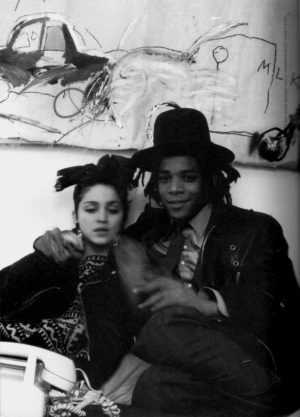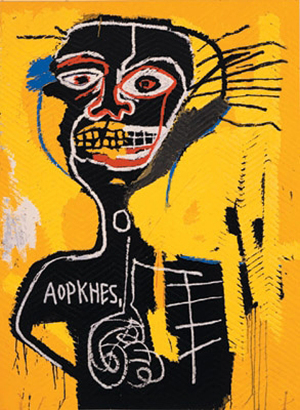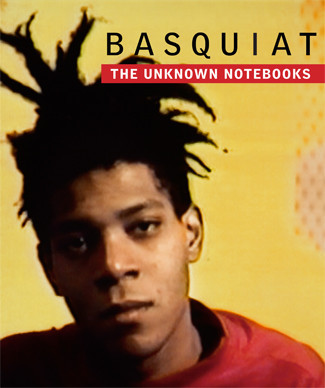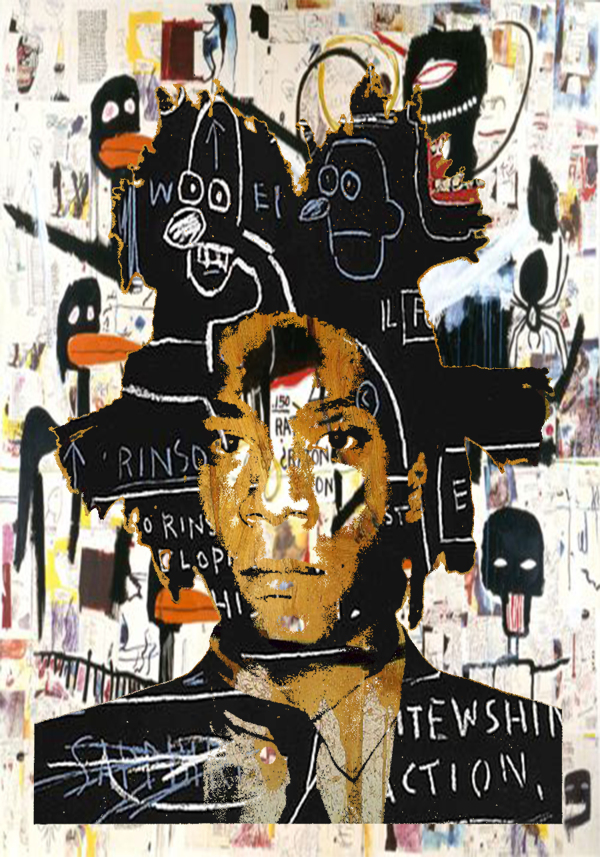Jean-Michel Basquiat (December 22, 1960 – August 12, 1988)
“Basquiat’s canon revolves around single heroic figures: athletes, prophets, warriors, cops, musicians, kings and the artist himself. In these images the head is often a central focus, topped by crowns, hats, and halos. In this way the intellect is emphasized, lifted up to notice, privileged over the body and the physicality of these figures (i.e. black men) commonly represent in the world.”
—Kellie Jones, Lost in Translation: Jean-Michel in the (Re)Mix[27]
WIKIPEDIA: Fred Hoffman hypothesizes that underlying Basquiat’s sense of himself as an artist was his “innate capacity to function as something like an oracle, distilling his perceptions of the outside world down to their essence and, in turn, projecting them outward through his creative acts.”[2] Additionally, continuing his activities as a graffiti artist, Basquiat often incorporated words into his paintings. Before his career as a painter began, he produced punk-inspired postcards for sale on the street, and became known for the political–poetical graffiti under the name of SAMO. On one occasion Basquiat painted his girlfriend’s dress with the words “Little Shit Brown”. He would often draw on random objects and surfaces, including other people’s property. The conjunction of various media is an integral element of Basquiat’s art. His paintings are typically covered with text and codes of all kinds: words, letters, numerals, pictograms, logos, map symbols, diagrams and more.[28]
FINANCIAL TIMES: FINANCIAL REVIEW: When the young black American artist Jean-Michel Basquiat rose to fame, two decades after that impassioned address,  King’s dream was still far from a reality. Subtitled Now’s the Time, Guggenheim Bilbao’s fine retrospective argues that the work of this pioneering painter, who tore through the white art world of 1980s New York with his barbed responses to injustice and police brutality, remains as relevant now as then, the recent deaths of Michael Brown, Freddie Gray and others having again shone a light on US race relations. Born in Brooklyn to a Puerto Rican mother and a Haitian father, Basquiat had a middle-class upbringing full of books and museum visits. He left home in 1978 a precocious teenager without a high-school diploma, but his poetic graffiti under the tag SAMO (“same old shit”) caught the attention of SoHo residents. That he chose to inscribe his art on the walls of the gallery district indicates his ambitions. Basquiat’s rise to fame was swift. He took part in the landmark Times Square Show and New York/New Wave exhibitions of 1980 and 1981, before selling out his first solo show at Annina Nosei the following year. He collaborated with Andy Warhol, DJed at fashionable clubs, partied with the likes of David Bowie and for a time dated Madonna. MORE
King’s dream was still far from a reality. Subtitled Now’s the Time, Guggenheim Bilbao’s fine retrospective argues that the work of this pioneering painter, who tore through the white art world of 1980s New York with his barbed responses to injustice and police brutality, remains as relevant now as then, the recent deaths of Michael Brown, Freddie Gray and others having again shone a light on US race relations. Born in Brooklyn to a Puerto Rican mother and a Haitian father, Basquiat had a middle-class upbringing full of books and museum visits. He left home in 1978 a precocious teenager without a high-school diploma, but his poetic graffiti under the tag SAMO (“same old shit”) caught the attention of SoHo residents. That he chose to inscribe his art on the walls of the gallery district indicates his ambitions. Basquiat’s rise to fame was swift. He took part in the landmark Times Square Show and New York/New Wave exhibitions of 1980 and 1981, before selling out his first solo show at Annina Nosei the following year. He collaborated with Andy Warhol, DJed at fashionable clubs, partied with the likes of David Bowie and for a time dated Madonna. MORE
WIKIPEDIA: On February 10, 1985, he appeared on the cover of The New York Times Magazine in a feature titled “New Art, New Money: The Marketing of an American Artist”.[39] He was a successful artist in this period, but his growing heroin addiction began to interfere with his personal relationships. When Andy Warhol died on February 22, 1987, Basquiat became increasingly isolated, and his heroin addiction and depression grew more severe.[16] Despite an attempt at sobriety during a trip to Maui, Hawaii, he died on August 12, 1988, of a heroin overdose at his art studio on Great Jones Street in Manhattan’s NoHo neighborhood. He was 27.[16][40]
Until 2002, the highest money paid for an original work of Basquiat’s was US$3,302,500, set on November 12, 1998 at Christie’s. In 2002, Basquiat’s Profit I (1982), a large piece measuring 86.5″/220 cm by 157.5″/400 cm, was set for auction again at Christie’s by drummer  Lars Ulrich of the heavy metal band Metallica. It sold for US$5,509,500.[58] The proceedings of the auction are documented in the film Some Kind of Monster. In 2008, at another auction at Christie’s, Ulrich sold a 1982 Basquiat piece, Untitled (Boxer), for US $13,522,500 to an anonymous telephone bidder. Another record price for a Basquiat painting was made on in 2007, when an untitled Basquiat work from 1981 sold at Sotheby’s in New York for US$14.6 million.[59] In 2012, for the second year running, Basquiat was the most coveted contemporary (i.e. born after 1945) artist at auction, with €80m in overall sales.[60] That year, his Untitled (1981), a painting of a haloed, black-headed man with a bright red skeletal body, depicted amid the artist’s signature scrawls, was sold by Robert Lehrman for $16.3 million, well above its $12 million high estimate.[61] A similar untitled piece, also undertaken in 1981 and formerly owned by the Israel Museum, sold for £12.92 million at Christie’s London, setting a world auction record for Basquiat’s work.[62]
Lars Ulrich of the heavy metal band Metallica. It sold for US$5,509,500.[58] The proceedings of the auction are documented in the film Some Kind of Monster. In 2008, at another auction at Christie’s, Ulrich sold a 1982 Basquiat piece, Untitled (Boxer), for US $13,522,500 to an anonymous telephone bidder. Another record price for a Basquiat painting was made on in 2007, when an untitled Basquiat work from 1981 sold at Sotheby’s in New York for US$14.6 million.[59] In 2012, for the second year running, Basquiat was the most coveted contemporary (i.e. born after 1945) artist at auction, with €80m in overall sales.[60] That year, his Untitled (1981), a painting of a haloed, black-headed man with a bright red skeletal body, depicted amid the artist’s signature scrawls, was sold by Robert Lehrman for $16.3 million, well above its $12 million high estimate.[61] A similar untitled piece, also undertaken in 1981 and formerly owned by the Israel Museum, sold for £12.92 million at Christie’s London, setting a world auction record for Basquiat’s work.[62]
BROOKLYN MUSEUM: Brooklyn-born artist Jean-Michel Basquiat filled numerous notebooks with poetry fragments, wordplay, sketches, and personal observations ranging from street life and popular culture to themes of race, class, and world history. The first major exhibition of the artist’s notebooks, Basquiat: The Unknown Notebooks features 160 pages of these rarely seen documents, along with related works on paper and large-scale paintings. A self-taught artist with encyclopedic and cross-cultural interests, Basquiat was influenced by comics, advertising, children’s sketches, Pop art, hip-hop, politics, and everyday life. Basquiat: The Unknown Notebooks emphasizes the distinct interplay of text and images in  Basquiat’s art, providing unprecedented insight into the importance of writing in the artist’s process. The notebook pages on display contain early renderings of iconic imagery—tepees, crowns, skeleton-like figures, and grimacing faces—that also appear throughout his large-scale works, as well as an early drawing related to his series of works titled Famous Negro Athletes. MORE
Basquiat’s art, providing unprecedented insight into the importance of writing in the artist’s process. The notebook pages on display contain early renderings of iconic imagery—tepees, crowns, skeleton-like figures, and grimacing faces—that also appear throughout his large-scale works, as well as an early drawing related to his series of works titled Famous Negro Athletes. MORE
PBS: Centered on a rare interview that director and friend Tamra Davis shot with Jean-Michel Basquiat more than 20 years ago, this film chronicles the meteoric rise and fall of the young artist. In the crime-ridden New York City of the 1970s, he covers the city with the graffiti tag ‘SAMO.’ In 1981 he puts paint on canvas for the first time, and by 1983 he is an artist with “rock star status.” He achieves critical and commercial success, though he is constantly confronted by racism from his peers. In 1985, he and Andy Warhol become close friends and painting collaborators, but they part ways and Warhol dies suddenly in 1987. Basquiat’s heroin addiction worsens, and he dies of an overdose in 1988 at the age of 27. The artist was 25 years old at the height of his career, and today his canvases sell for more than a million dollars. MORE
“BASQUIAT: THE UNKNOWN NOTEBOOKS” @ BROOKLYN MUSEUM UNTIL 8/23

